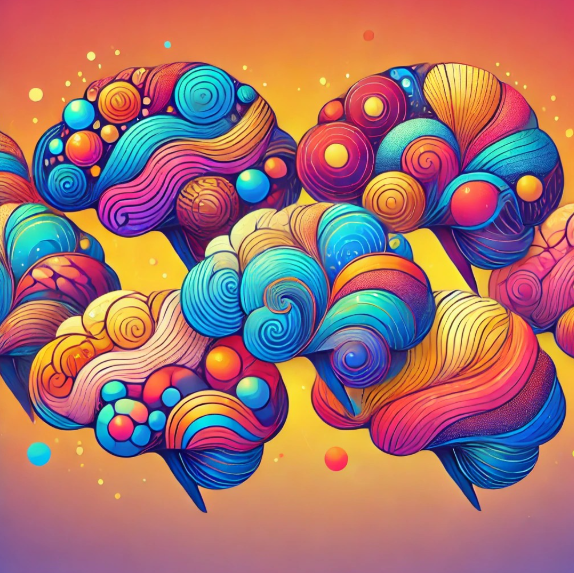
What Is Sensory Processing
Sensory processing is how our brain takes in and responds to information from the world around us—and from inside our own bodies. For many neurodivergent people, especially those with ADHD, Autism, and Tourette’s Syndrome, this system works differently. When sensory input is too strong, too weak, or hard to understand, it can lead to overwhelm, anxiety, meltdowns, shutdowns, or confusion. That's why sensory support is essential for all of the neurodivergent conditions and often a significant part of finding bespoke ways to manage your neurodivergence. Unfortunately with ADHD and Tourettes this is often overlooked with no support offered following diagnosis.
Two Common Types of Sensory Processing Challenges
1. Sensory Modulation Difficulties
Trouble regulating responses to sensory input. This can look like:
○ Overreacting to sounds, lights, or touch
○ Seeking constant movement or pressure
○ Fluctuating between hyper- and hypo-sensitivity
2. Sensory Discrimination Difficulties
Difficulty telling the difference between sensory inputs or locating them accurately. This may show up as:
○ Not knowing where a sound came from
○ Trouble coordinating movement or using the right force
○ Not noticing injuries or hunger cues
The 8 Sensory Systems (Yes, Eight!)
*
The 8 Sensory Systems (Yes, Eight!) *
Most people know the main five senses, but we actually have eight:
1. Visual (Sight) – Bright lights or fast movement can cause distress or distraction.
2. Auditory (Hearing) – Background noise may feel overwhelming; certain sounds can be painful.
3. Tactile (Touch) – Light touch may feel irritating, or pressure may be calming; tags or seams in clothing can feel unbearable.
4. Olfactory (Smell) – Strong or specific smells may cause nausea or distraction.
5. Gustatory (Taste) – Picky eating or extreme reactions to food textures/flavors.
6. Vestibular (Balance & Movement) – Difficulty with spinning, swinging, or balancing; craving movement or avoiding it.
7. Proprioceptive (Body Awareness) – Difficulty sensing where body parts are; clumsiness or crashing into things; seeking deep pressure or squeezing.
8. Interoception (Internal Body Signals) – Trouble recognizing hunger, thirst, needing the toilet, pain, or emotional states.
Why Sensory Regulation Is Crucial for Neurodivergent People
When the sensory system is unregulated, it can trigger:
● Anxiety
● Increase hyperactive thinking in ADHD
● Exhaustion
● Emotional outbursts and more difficulty regulating emotions
● Difficulty concentrating, which is already difficult for those with executive functioning difficulties.
● Increases in internal sensations and tics.
● Difficulty communication your needs
● It can trigger the fight, flight and freeze response putting you in a constant state of anxiety and overwhelm
Regulating the sensory system helps reduce overwhelm, improve focus, and support emotional and physical wellbeing. Each person’s sensory profile is different—what soothes one person may stress another. You may not even realise you have sensory difficulties until you unpick this element, and see yourself and neurodivergence through a sensory lens
Dyspraxia (DCD) & Sensory Processing
Dyspraxia, also known as Developmental Coordination Disorder (DCD), is a
neurodevelopmental condition that affects a person’s ability to plan, sequence, and execute
coordinated movements. It’s not caused by muscle weakness, but by how the brain processes
information and sends instructions to the body.
Many people with dyspraxia also experience sensory processing challenges, especially with
the vestibular, proprioceptive, and tactile systems.
How Dyspraxia Interacts with the Sensory System
● Proprioceptive difficulties: Trouble sensing body position and movement can lead to
clumsiness, bumping into things, or using too much or too little force.
● Vestibular challenges: Struggles with balance, posture, and spatial awareness can
affect walking, sitting upright, or riding a bike.
● Tactile sensitivity: Light touch or specific clothing textures may be distracting or
uncomfortable.
These difficulties can make everyday tasks such as handwriting, using utensils, tying shoelaces,
or participating in sports more frustrating or tiring.

These neurodivergent conditions often overlap and share common sensory traits:
● ADHD may cause sensory seeking (e.g., fidgeting or movement to stay alert)
● Autism may cause sensory sensitivity (e.g., avoidance of loud or busy places)
● Tourette’s may be affected by internal sensory dysregulation, making tics harder to manage, particularly in the areas of interoception and proprioception.
This overlap can intensify sensory and coordination issues, making it even more important to understand and support the full neurodivergent profile.
Early intervention and sensory-informed strategies can significantly improve confidence and independence.
Your sensory system is a foundation of how you experience the world—learning to support it changes everything.
👉 Explore More
🔗 Please see our dedicated page on autism, ADHD, and Tourette’s to understand how these conditions interact.



